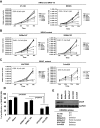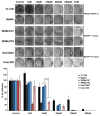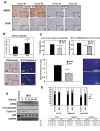Methylthioadenosine (MTA) inhibits melanoma cell proliferation and in vivo tumor growth
- PMID: 20529342
- PMCID: PMC2891639
- DOI: 10.1186/1471-2407-10-265
Methylthioadenosine (MTA) inhibits melanoma cell proliferation and in vivo tumor growth
Abstract
Background: Melanoma is the most deadly form of skin cancer without effective treatment. Methylthioadenosine (MTA) is a naturally occurring nucleoside with differential effects on normal and transformed cells. MTA has been widely demonstrated to promote anti-proliferative and pro-apoptotic responses in different cell types. In this study we have assessed the therapeutic potential of MTA in melanoma treatment.
Methods: To investigate the therapeutic potential of MTA we performed in vitro proliferation and viability assays using six different mouse and human melanoma cell lines wild type for RAS and BRAF or harboring different mutations in RAS pathway. We also have tested its therapeutic capabilities in vivo in a xenograft mouse melanoma model and using variety of molecular techniques and tissue culture we investigated its anti-proliferative and pro-apoptotic properties.
Results: In vitro experiments showed that MTA treatment inhibited melanoma cell proliferation and viability in a dose dependent manner, where BRAF mutant melanoma cell lines appear to be more sensitive. Importantly, MTA was effective inhibiting in vivo tumor growth. The molecular analysis of tumor samples and in vitro experiments indicated that MTA induces cytostatic rather than pro-apoptotic effects inhibiting the phosphorylation of Akt and S6 ribosomal protein and inducing the down-regulation of cyclin D1.
Conclusions: MTA inhibits melanoma cell proliferation and in vivo tumor growth particularly in BRAF mutant melanoma cells. These data reveal a naturally occurring drug potentially useful for melanoma treatment.
Figures




Similar articles
-
Repurposing the serotonin agonist Tegaserod as an anticancer agent in melanoma: molecular mechanisms and clinical implications.J Exp Clin Cancer Res. 2020 Feb 21;39(1):38. doi: 10.1186/s13046-020-1539-7. J Exp Clin Cancer Res. 2020. PMID: 32085796 Free PMC article.
-
The combination of MLN2238 (ixazomib) with interferon-alpha results in enhanced cell death in melanoma.Oncotarget. 2016 Dec 6;7(49):81172-81186. doi: 10.18632/oncotarget.12791. Oncotarget. 2016. PMID: 27783987 Free PMC article.
-
Novel small molecule XPO1/CRM1 inhibitors induce nuclear accumulation of TP53, phosphorylated MAPK and apoptosis in human melanoma cells.PLoS One. 2014 Jul 24;9(7):e102983. doi: 10.1371/journal.pone.0102983. eCollection 2014. PLoS One. 2014. PMID: 25057921 Free PMC article.
-
RAS pathway regulation in melanoma.Dis Model Mech. 2022 Feb 1;15(2):dmm049229. doi: 10.1242/dmm.049229. Epub 2022 Mar 2. Dis Model Mech. 2022. PMID: 35234863 Free PMC article. Review.
-
5'-Methylthioadenosine and Cancer: old molecules, new understanding.J Cancer. 2019 Jan 29;10(4):927-936. doi: 10.7150/jca.27160. eCollection 2019. J Cancer. 2019. PMID: 30854099 Free PMC article. Review.
Cited by
-
Characterization of the Methylthioadenosine Phosphorylase Polymorphism rs7023954 - Incidence and Effects on Enzymatic Function in Malignant Melanoma.PLoS One. 2016 Aug 1;11(8):e0160348. doi: 10.1371/journal.pone.0160348. eCollection 2016. PLoS One. 2016. PMID: 27479139 Free PMC article.
-
Oral methylthioadenosine administration attenuates fibrosis and chronic liver disease progression in Mdr2-/- mice.PLoS One. 2010 Dec 29;5(12):e15690. doi: 10.1371/journal.pone.0015690. PLoS One. 2010. PMID: 21209952 Free PMC article.
-
Bifidobacterium alleviate metabolic disorders via converting methionine to 5'-methylthioadenosine.Gut Microbes. 2024 Jan-Dec;16(1):2300847. doi: 10.1080/19490976.2023.2300847. Epub 2024 Mar 4. Gut Microbes. 2024. PMID: 38439565 Free PMC article.
-
BRAF activation by metabolic stress promotes glycolysis sensitizing NRASQ61-mutated melanomas to targeted therapy.Nat Commun. 2022 Nov 19;13(1):7113. doi: 10.1038/s41467-022-34907-0. Nat Commun. 2022. PMID: 36402789 Free PMC article.
-
Targeting tumors that lack methylthioadenosine phosphorylase (MTAP) activity: current strategies.Cancer Biol Ther. 2011 Apr 1;11(7):627-32. doi: 10.4161/cbt.11.7.14948. Epub 2011 Apr 1. Cancer Biol Ther. 2011. PMID: 21301207 Free PMC article. Review.
References
-
- Savarese TM, Ghoda LY, Dexter DL, Parks RE Jr. Conversion of 5'-deoxy-5'-methylthioadenosine and 5'-deoxy-5'-methylthioinosine to methionine in cultured human leukemic cells. Cancer Res. 1983;43(10):4699–4702. - PubMed
-
- Olopade OI, Pomykala HM, Hagos F, Sveen LW, Espinosa R, Dreyling MH, Gursky S, Stadler WM, Le Beau MM, Bohlander SK. Construction of a 2.8-megabase yeast artificial chromosome contig and cloning of the human methylthioadenosine phosphorylase gene from the tumor suppressor region on 9p21. Proc Natl Acad Sci USA. 1995;92(14):6489–6493. doi: 10.1073/pnas.92.14.6489. - DOI - PMC - PubMed
Publication types
MeSH terms
Substances
LinkOut - more resources
Full Text Sources
Medical
Research Materials

